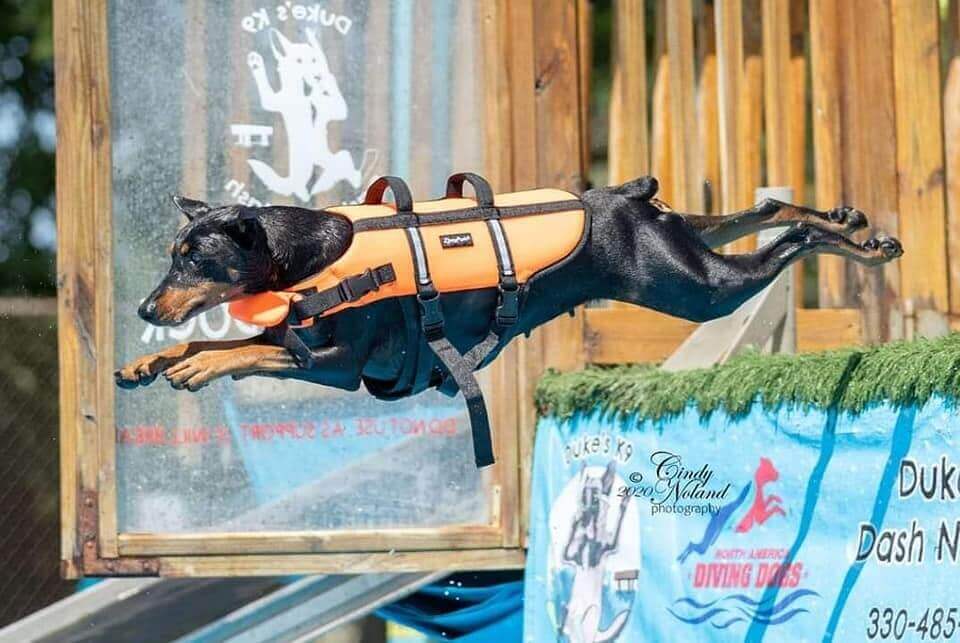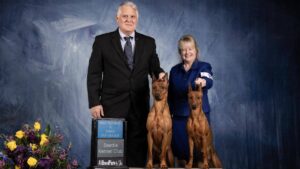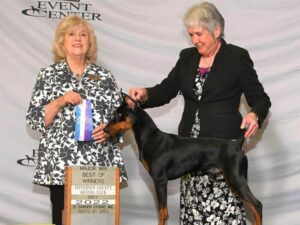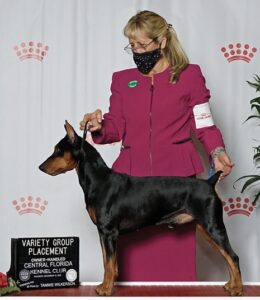
Find Yourself With A German Pinscher
Discover the versatile German Pinscher: a fearless, intelligent working dog excelling in sports, obedience, and companionship.
Home » Meet The Breeds » German Pinscher

The German Pinscher is a medium-sized, athletic breed with a strong work ethic and a history rooted in Deutschland. Known for its intelligence, agility, and versatility, the breed has served as a farm dog, vermin hunter, and loyal companion for two centuries.
Working
17 – 20 inches
25 – 45 pounds
12 – 14 years
| Country of Origin | Germany |
|---|---|
| Bred For | Vermin Control, Guarding |
| Known For | Elegant Appearance, Intelligence, Watchfulness |
| Popularity | Low |
| Temperament | Intelligent, Fearless, Vigilant |
| Activities | Farm Duties, Conformation Shows, Dog Sports |
The German Pinscher traces its origins back to the 19th century in Germany, where it was developed as a versatile working dog. Its primary role was to eliminate vermin and protect farms, making it an essential companion for farmers.
The breed is believed to have descended from the Rat Pinscher, a now-extinct German breed, and shares its ancestry with the Miniature Pinscher, Doberman Pinscher, and other pinscher-type breeds. It was officially recognized as a distinct breed in Germany in the late 19th century.
By the early 20th century, the German Pinscher’s popularity began to decline, and the breed nearly faced extinction after World War II. Dedicated breeders, led by Werner Jung in the 1950s, revived the breed by carefully selecting dogs that exhibited the traditional traits of the breed.
The German Pinscher was officially recognized by the Fédération Cynologique Internationale (FCI) in 1955. The American Kennel Club (AKC) granted full recognition to the breed in 2003, placing it in the Working Group where its versatility and intelligence are celebrated.
While less common than the other pinscher breeds, the German Pinscher is highly regarded for its agility, loyalty, and adaptability. Its role has evolved from farm work to include participation in competitive dog sports and serving as a devoted family companion.
The German Pinscher is a medium-sized breed, with adult males and females standing between 17 and 20 inches tall at the shoulder. Both males and females typically weigh between 25 and 45 pounds and have a lean, muscular build that reflects their elegance and athleticism.
The German Pinscher has a square, well-proportioned body, with its height at the withers approximately equal to its length from the prosternum to the rump. Its strong, compact frame conveys agility and endurance, emphasizing the breed’s working heritage.
Texture: The German Pinscher has a short, dense, and smooth coat that lies close to the body. The coat is shiny and covers the body without any bald spots.
| Standard Color | |
|---|---|
| Black | y |
| Blue | y |
| Fawn (Isabella) | y |
| Red | y |
| Standard Marking | |
|---|---|
| Red Markings | y |
| Red & Tan Markings | y |
| Tan Markings | y |
The German Pinscher’s tail is traditionally docked between the second and third joints. It is moderately set and carried above horizontal. The undocked tail has a sabre or sickle carriage.
The German Pinscher is a highly energetic and intelligent breed, making it an excellent choice for active families or individuals who can meet its physical and mental needs. It is a reliable watchdog due to its natural alertness, but its assertive nature requires consistent training and thoughtful socialization.
The German Pinscher is generally a healthy breed with a lifespan of 12 to 14 years. However, like all dogs, individuals may be prone to some health issues that require attention and proactive care.
The German Pinscher can experience the following health conditions:
German Pinschers are intelligent, energetic, and confident dogs that thrive on close relationships with their families. Their natural alertness and protective instincts make them excellent watchdogs, while their affectionate and playful nature ensures they are loving companions.
These dogs are generally good with children when raised alongside them but may be reserved around strangers or other animals without proper socialization. Due to their strong-willed and independent nature, they are best suited for experienced owners who can provide firm and consistent leadership.
German Pinschers require a high-quality diet to support their active lifestyle and maintain their lean, muscular build. Puppies should be fed specially formulated puppy food for medium-sized breeds, divided into three or four meals daily to support the growth phases.
Adult German Pinschers typically need 1.5 to 2.5 cups of food per day, divided into two meals, depending on their age, size, and activity level. Consistent feeding schedules, access to fresh water, and avoiding overfeeding are essential to prevent obesity and other health-related issues.
German Pinschers are highly intelligent and quick learners, but their strong-willed nature requires consistent and structured training. Early obedience training and socialization are crucial for teaching good manners and to ensure the dogs are comfortable around people and other animals.
This breed responds best to positive reinforcement techniques, such as treats and praise, and mentally stimulating activities that challenge their intelligence. Without proper training and boundaries, German Pinschers can become overly independent or develop behavioral issues, so consistency and patience are key to raising a well-mannered companion.
The German Pinscher is an energetic and athletic breed that requires at least 60 minutes of daily exercise to remain physically and mentally healthy. Activities such as brisk walks, running, or engaging in dog sports like Agility or Obedience are ideal for this active breed.
| Energy Level | High |
|---|---|
| Exercise Requirements | 1 Hour/Day (Minimum), Daily Walks, Vigorous Running, Regular Exercise, Mental Stimulation |
These dogs also benefit from mental stimulation, such as puzzle toys or training sessions, to keep their sharp minds engaged. Without sufficient exercise, German Pinschers may become bored, leading to unwanted behaviors such as chewing or excessive barking.
German Pinschers have a low-maintenance grooming routine thanks to their short, dense coat. Weekly brushing with a soft-bristle brush or grooming glove is usually sufficient to remove the loose hair and maintain a healthy, shiny coat.
| Coat Type | Short, Dense, Smooth, Shiny |
|---|---|
| Grooming Requirements | Weekly Brushing, Occasional Bathing, Routine Ear Cleaning, Periodic Nail Trimming, Regular Tooth Brushing |
Bathing is only needed occasionally or when the dog gets dirty, as overbathing can strip the coat of its natural oils. Routine care, including trimming nails, cleaning ears, and brushing teeth, is essential to keep the German Pinscher in good health and looking its best.
German Pinschers are highly adaptable and can thrive in a variety of living situations, including apartment settings, as long as their exercise needs are met. These dogs do best in homes where they can be part of daily activities, as they are people-oriented and form strong bonds with their families.
This breed is sensitive to extreme temperatures, tolerating heat better than cold due to the breed’s short coat. German Pinschers are happiest in environments that provide structure, attention, and plenty of opportunities for both physical and mental stimulation.
German Pinscher puppies are energetic, curious, and highly intelligent, requiring early guidance to positively shape good behavior. Their active and playful nature means they need structured training, socialization, and consistent routines to grow into well-mannered adults.
Caring for a German Pinscher puppy begins with creating a safe environment and establishing a consistent routine. Puppy-proofing the home is essential, as the pup’s curiosity may lead it to explore the immediate surroundings and get into trouble.
Early socialization is crucial to help the puppy develop into a confident and well-adjusted adult. Exposure to different people, environments, and animals encourages interactions that are adaptable and positive.
A high-quality puppy food formulated for medium-sized breeds supports the puppy’s growth and energy needs. Feeding should be scheduled in three to four small meals daily, transitioning to two meals as the pup matures.
Training should start immediately, focusing on basic obedience, housebreaking, and crate training. Positive reinforcement methods, such as treats and praise, are most effective for supporting progress in this intelligent breed.
Routine vet check-ups, vaccinations, and parasite prevention, as well as regular communication with the puppy’s breeder, are vital to monitor overall health and ensure a strong start in life.
The German Pinscher is recognized by the world’s leading registries and kennel organizations, which categorize the breed into a specific Group based on its unique characteristics. This breed is recognized worldwide under the following Group designations:
| Organization | Group Designation |
|---|---|
| AKC (American Kennel Club) | Working |
| UKC (United Kennel Club) | Terrier |
| CKC (Canadian Kennel Club) | Non-Sporting |
| ANKC (Australian National Kennel Council) | Not Recognized |
| RKC (The Royal Kennel Club) | Working |
| FCI (Fédération Cynologique Internationale) | Group 2: Pinscher and Schnauzer Molossoid Breeds – Swiss Mountain and Cattle Dogs; Section 1: Pinscher and Schnauzer Type |
The ideal German Pinscher is described by a Breed Standard that is approved by each of the world’s leading registries and kennel organizations. The Breed Standards for this breed may be found in the following links:
| Organization | Breed Standard |
|---|---|
| American Kennel Club | AKC German Pinscher Breed Standard |
| United Kennel Club | UKC German Pinscher Breed Standard |
| Canadian Kennel Club | CKC German Pinscher Breed Standard |
| Australian National Kennel Council | ANKC Not Recognized |
| The Royal Kennel Club | RKC German Pinscher Breed Standard |
| Fédération Cynologique Internationale | FCI German Pinscher Breed Standard |
Yes, German Pinschers shed, but their short, dense coat makes the shedding minimal and easy to manage. Regular brushing helps to keep the coat healthy and removes any loose hair.
No, German Pinschers are not hypoallergenic. While they shed minimally, they still produce dander that can trigger allergies in sensitive individuals.
German Pinschers typically live between 12 and 14 years. With proper care, exercise, and a healthy diet, they can enjoy a long and active life.
Yes, German Pinschers can be excellent family dogs when properly socialized. They are affectionate, loyal, and energetic, making them great companions for active households with a focus on training.
German Pinschers are naturally alert and may bark to warn their owners of potential threats. However, with proper training, any excessive barking can usually be controlled.

Discover the versatile German Pinscher: a fearless, intelligent working dog excelling in sports, obedience, and companionship.

Howard & Lorraine Shore of Immer Treu share their passion for preserving and promoting the rare, loyal, and agile German Pinscher.

Amy Issleib is the breeder behind Temerity German Pinschers. Read about the kennel’s beginnings, the puppies, and much more!

Valerie Schluter | Diamond Bay German Pinschers : I came from a family that raised Boxers; many still do. But for 30 years